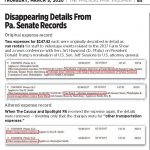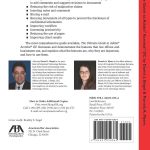PDF users beware: If you don’t know how to redact, or how redaction and PDF editing work, you may have problems. Today’s Philadelphia Inquirer has an article that highlights how easy it to “edit” PDFs. The article spotlights how documents containing Pennsylvania State Senate expense records appear to have “changed” over time. For those who don’t understand PDFs, it may be confounding. On the other hand, if you have been trained how to use Adobe Acrobat software by Pam Myers and Dan Siegel of Integrated Technology Services, LLC, then you know how easy it is.
The example shown was likely “created” in one of two ways. The “author” could have simply edited the PDF, which is no different from editing a document created in Word or another similar program. Alternatively, the “author” could have redacted (removed) text and then rearranged the remaining text to “fit.” But the key here is that the redaction was clear, that is, invisible, and it’s easy to redact that way.
Fortunately for lawyers in Pennsylvania, Dan Siegel was a member of the Working Group that created the Public Access Policy and he was the driving force behind the requirement that redactions in all Court documents must be “visibly evident,” that is, you can look at a page and see the redactions. No hocus pocus needed.
Dan and Pam train lawyers and other Adobe Acrobat users all the time how to use the software. They also wrote the highly popular book, The Ultimate Guide to Adobe Acrobat DC, which includes instructions and screenshots of most of the features businesses and law offices use all the time. They also provide onsite and remote training. They’re the Acrobat experts who understand the software, and can teach you about it in a jargon-free manner.



